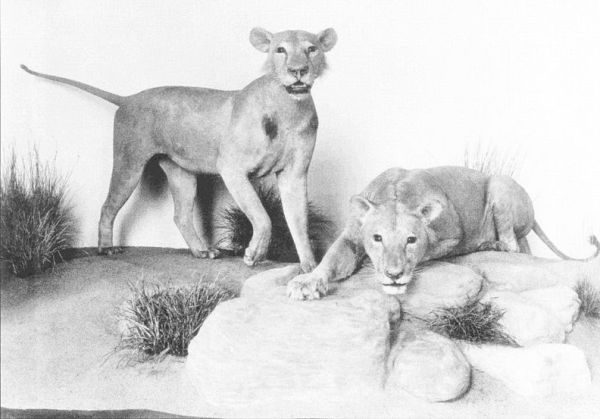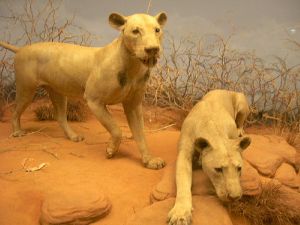
October 30, 2007

During the fall, coming in and out of the news, has been the demand from Kenya that Chicago’s Field Museum return the remains of two lions that reportedly killed about 135 Indian railworkers (but probably actually only about 25) in the 1890s, before being shot by a famed British railway engineer. These lions are the infamous maneaters of Tsavo.
Railway engineer Lieutenant-Colonel John Henry Patterson – whose adventures formed the basis of the Oscar-winning 1996 movie The Ghost and the Darkness, starring Michael Douglas and Val Kilmer, shot the strange cats in December 1898. Twenty-six years later Patterson sold the specimens, consisting of the lions’ skulls and hides, to Chicago’s Field Museum for US$5,000.
Now, however, Kenya, via the National Museum of Kenya, wants the mounted bodies back and hopes for them to be part of an upcoming exhibition in the U.S. on Kenyan history.

What interests me from a cryptozoological and zoological point of view is how unusual these lions are. Both males, perhaps brothers, they displayed almost no manes. These 1898 man-eaters were adults, between eight and ten years old; most males develop manes by age five. Maneless male lions are not unknown, but in this example, for them to be infamous killers as well, certainly makes them memorable.
Other maneless male lions have been found in the Tsavo area, in modern times.
It seems a tangible mystery, worthy of noting, as who knows what other maneless lions, in various ranges, have a natural human-eating side to them? Indeed research in the Tsavo area has shown that lions there have been eating humans long before the 1800s, and up until at least the 1940s and perhaps today, too.
Prehistoric humans were on the diet of lions long ago. It would have been more surprising had the human-feeding patterns among a small specific population of maneless lions in Kenya had stopped just because humans wanted to build a railroad through the country.
About Loren Coleman
Loren Coleman is one of the world’s leading cryptozoologists, some say “the” leading living cryptozoologist. Certainly, he is acknowledged as the current living American researcher and writer who has most popularized cryptozoology in the late 20th and early 21st centuries.
Starting his fieldwork and investigations in 1960, after traveling and trekking extensively in pursuit of cryptozoological mysteries, Coleman began writing to share his experiences in 1969. An honorary member of Ivan T. Sanderson’s Society for the Investigation of the Unexplained in the 1970s, Coleman has been bestowed with similar honorary memberships of the North Idaho College Cryptozoology Club in 1983, and in subsequent years, that of the British Columbia Scientific Cryptozoology Club, CryptoSafari International, and other international organizations. He was also a Life Member and Benefactor of the International Society of Cryptozoology (now-defunct).
Loren Coleman’s daily blog, as a member of the Cryptomundo Team, served as an ongoing avenue of communication for the ever-growing body of cryptozoo news from 2005 through 2013. He returned as an infrequent contributor beginning Halloween week of 2015.
Coleman is the founder in 2003, and current director of the International Cryptozoology Museum in Portland, Maine.
Filed under Alien Big Cats, Breaking News, Conspiracies, Cryptomundo Exclusive, Cryptotourism, CryptoZoo News, Cryptozoologists, Cryptozoology, Evidence, Eyewitness Accounts, Forensic Science, Mystery Cats